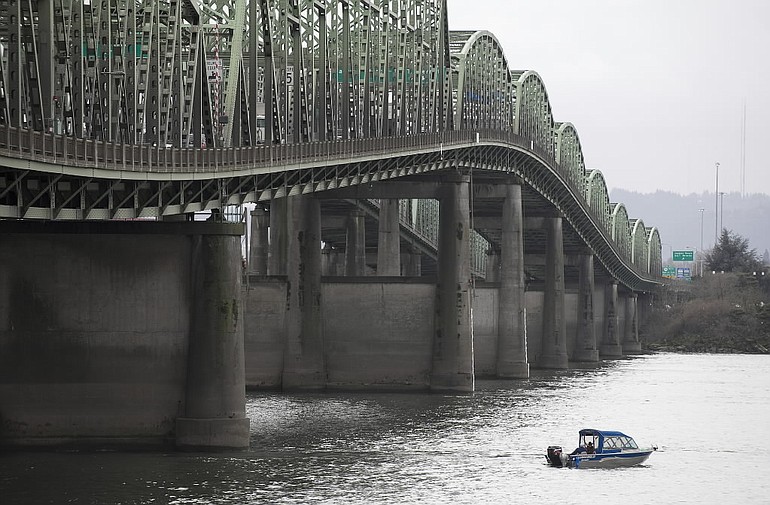I-5 Bridge will cast a long shadow over Vancouver
PORTLAND — Local and state officials on Monday unanimously endorsed a new 10-lane replacement for the Interstate 5 Bridge, along with a redesigned interchange on Hayden Island that’s likely to add $50 million to $100 million in costs to the $3.6 billion project.
“The monster interchange on Hayden Island has been tamed,” Portland Mayor Sam Adams declared Monday.
But plenty of tough issues remain to be resolved.
The chairman of a new independent review of the project told 10 members of the Project Sponsors Council that they would be well-advised to forget about finishing a formal record of decision by the start of next year.
Tom Warne said jamming the project through by the start of the year would be a “false victory” if a replacement of the existing twin three-lane drawbridges generates a lawsuit or continues to stir dissent from local elected officials. For example, Vancouver elected officials are beginning to raise new concerns about the new bridge’s six-block-wide landing zone in Vancouver, where it will enter the city at roughly the height of an eight-story building.
At the same time, Warne’s panel said the bridge employs a unique design that will require extensive testing to determine its cost and “constructibility.”
Warne estimated it would take at least another six months to test the design and address other issues cited by the review panel.
“You could crawl your way to a ROD (record of decision) in January of 2011,” he said. “You would still have rancor in the community, and you’d probably have people that would bring a lawsuit against you.”
Indeed, even though the sponsors council unanimously endorsed a bridge with 10 lanes and a refined interchange on Hayden Island, representatives of both Portland and Vancouver indicated they are less than satisfied with the appearance of the structure currently envisioned by project planners.
“Nobody I’ve talked to is saying, ‘Hallelujah, that’s an icon,’ ” Warne said.
The twin spans employ an open-web stacked design that’s never been built anywhere in the world. The stack includes automobile decks on top, with a pedestrian and bicycle path on the lower deck of one bridge and a light rail transit line running on the lower deck of the other span. The open web enables pedestrians and riders to peer out across the river rather than being confined inside a segmental box.
Warne, who previously headed the Utah Department of Transportation and has consulted on highway projects across the country, said there’s no guarantee the design will pass muster with federal highway officials.
He suggested the sponsors council might want to come up with a Plan B.
“Do you want to ride only one horse here?” he said. “And what if that horse can’t finish the ride?”
Although state and local planners spent months trying to lessen the bridge’s hulking footprint on Hayden Island, comparatively little attention has been paid to the structure’s landing zone in Vancouver.
Jeanne Harris, a Vancouver city councilor who is representing the city on the sponsors council, said she’s concerned about the structure’s effect on the city’s nascent effort to revitalize downtown and the riverfront. With tens of millions of dollars in private and public funding plowed into condos, office towers and a city-owned convention center, Harris said she’s concerned about a mass of nondescript concrete looming overhead.
Harris said she’s open to considering a bridge alignment just upstream from the existing I-5 bridge.
“I think everything’s on the table,” Harris said afterward. “We don’t want to start totally from scratch, but I think this opens up a dialogue.”
Washington-based bridge architect Kevin Peterson has been lobbying for an alternative that would shift the new bridge away from downtown to a parallel straight alignment just upstream from the current spans. Project planners have generally dismissed the idea as unworkable because of the proximity to Pearson Field and the Fort Vancouver National Site, but they have declined to respond specifically to Peterson’s idea.
On Monday, Vancouver and Portland’s mayors both criticized the appearance of the current design.
“I don’t think the design is worthy of the money we’re putting into it,” Adams said.
Vancouver Mayor Tim Leavitt, a professional engineer, suggested dumping the stacked design and instead go back to designing a third bridge for light rail and pedestrians. Leavitt has expressed concern about the project’s “monumental” profile entering Vancouver, and a single-deck design could flatten the height, he said. However, it would also add more piers in the river while widening the combined presence of structures across the water.
“I’m looking for a bridge that is safe and efficient and viable from an engineering perspective,” Leavitt said afterward.
Leavitt, who has taken heat over his decision a month ago to grudgingly support tolls for the new bridge, noted that the bridge design has evolved over time to meet myriad goals. It has to be tall enough to allow boats to pass without stopping traffic and low enough to allow 175 small planes to continue using Pearson Field. Washington wants to boost highway capacity, while Oregon has pushed for light rail. And all of it has to fit in a tight urban corridor.
“Have we evolved it to a species that’s going to live?” Leavitt asked.
The bistate Columbia River Crossing office last November had proposed a 10-lane span, rather than the 12 lanes previously agreed to, but Monday’s action marked the first time all project sponsors endorsed the refined version.
Adams had pushed for a bridge as small as six lanes, saying he was concerned about shifting rush-hour congestion from the river into the center of Portland. He said he’s now satisfied that 10 lanes is reasonable.
Erik Robinson: 360-735-4551, or erik.robinson@columbian.com.



